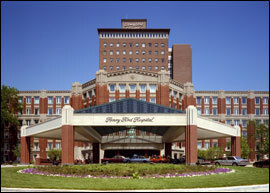by
Amanda Doreson, Project Manager | February 19, 2007

Henry Ford Hospital, Detroit, Mich.
Researchers at Henry Ford Hospital are using a 3-D video camera to take detailed snapshots during breast cancer radiation treatment to improve the accuracy of treatment.
Henry Ford Hospital is believed to be the first in the world to use this innovative technology for routine breast cancer treatment.
Preliminary results of a study being conducted at Henry Ford Hospital show that the 3-D video camera used during the planning and treatment stage has doubled the accuracy of treatment. Improved accuracy may reduce potential side effects such as damaging surrounding tissue and organs, like the lung and heart.
Prior to radiation treatment, planning is done through 3-D imaging of the patient's breast with a CT scan to track the tumor site. "Although the 3-D capability has improved precision of treatment during the treatment planning stage, the use of the 3-D video camera allows doctors to visualize the targeted breast tumor site during the actual treatment," says Shidong Li, Ph.D., head of the radiation physics division who first introduced and developed the image-guided technology to be used with radiation treatment.
The 3-D video guided system allows clinicians to compare images taken during the CT simulation used for treatment planning with the snapshot images taken during the treatment stage to make sure changes in the targeted area have not occurred.
"This technology is useful because even subtle changes such as a change in breathing or a different arm position can result in minor deviations of the targeted treatment area from when the planning stage occurred," says Eleanor Walker, M.D., radiation oncologist who uses the technology at Henry Ford Hospital.
The 3-D video camera which is mounted on the ceiling of the treatment room and does not use radiation, is not associated with any side effects to the patient.
"This technology is very important because we now have the capability of having detailed images of the targeted area in real time," says Benjamin Movsas, M.D., chair of Radiation Oncology at Henry Ford Health System. "While we are currently using the 3-D video guidance for breast cancer treatment, we expect to use the technology for other tumor sites in the future such as the head and neck area."
For further information on the study call the Radiation Oncology Department at Henry Ford Hospital at 313-916-3938.
